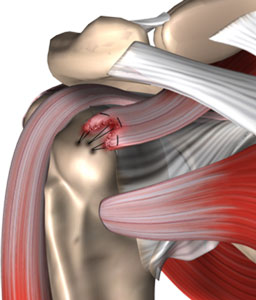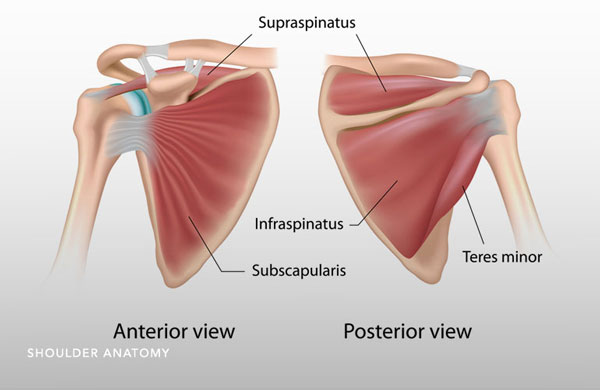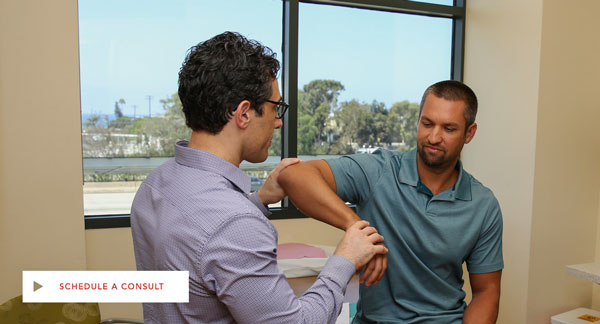
Rotator cuff tears affect older adults and athletes. Studies show that up to two thirds of people over the age of 70 have rotator cuff tears, and no symptoms.
What is the rotator cuff?
The rotator cuff is a bundle of muscles and tendons, covered by the bursa, a sack of tissue that protects the cuff from contacting the bones. The rotator cuff holds the upper arm bone in the shoulder socket. It allows us to raise and rotate the arm and provides strength and stability to the joint.

What is a rotator cuff tear?
A rotator cuff tear is the tear of a rotator cuff tendon and means the tendon is no longer fully attached to the humerus, the upper arm bone. It is a common injury that can cause pain and disability. Most cuff tears are the result of wear and tear. Many sports activities rely on a healthy rotator cuff including baseball, tennis and swimming.
What causes a rotator cuff tear?
Tears can result from an accident, a sudden fall on the arm, lifting heavy objects, repetitive use, and aging and deterioration of the tendon and muscles. The tear may be a partial or full thickness tear.
What are the symptoms of a rotator cuff tear?
- But, tears are not always painful and many people have no symptoms.
- Shoulder weakness that impairs daily life activities like brushing your hair or getting dressed
- Difficulty with overhead movements
- Pain that increases at night
- Restricted motion
- Catching and locking of the joint
- A feeling of instability
Symptoms tend to worsen when reaching backward to fasten a seatbelt, or pick up a heavy object, lifting heavy objects overhead, and with sports like pitching, throwing, tennis and racket ball.
How is a rotator cuff injury diagnosed?
Dr. Stark will take a full medical history and conduct a careful physical exam with certain muscle tests to determine if there are tears and rule out other conditions. Many times, tears can be diagnosed easily in Dr. Stark’s office.
He may order x-rays to rule out arthritis, and bone spurs, and to view the position of the bones which can imply a tear. An MRI will diagnose the tears and reveal their size, type and location. Early treatment can help you avoid further damage.

Treatment
The vast majority of patients experience pain and function improvement with conservative treatment. Rest, activity modification, anti-inflammatory medications, cortisone injections and physical therapy will control pain and may be sufficient to help the patient regain function. When conservative treatments fail to reduce pain and disability, surgical intervention will be recommended.
Who is a good candidate for rotator cuff surgery?
In young patients, surgery may be the first choice because when done early after injury these patients recover well. This early surgery option is only for patients who are younger than 50 with tears less than a month old.
Surgery can be a good option when:
- pain does not improve with conservative methods
- you are active and use your arms for work and sports
- your symptoms have lasted for six to twelve months
- you have a large tear, and the tendon tissues is in good shape
- you have significant loss of shoulder function
- the tear is due to a recent, acute injury
Surgical repair
The goal of surgery is to heal the tendon. The type of surgery depends on the size of your tear, the quality of the tendon and bone tissue, and whether there are other shoulder problems like osteoarthritis, bone spurs and other damage.
Surgical repair involves re-attaching the tendon to the upper arm bone. A partial tear may only require debridement, trimming or smoothing of the frayed tendon. Large and complex tears may require open surgery.
Often surgery can be done as an outpatient. Repairs can be performed with arthroscopy, open surgery and mini-open repair. You surgeon will recommend the type of surgery for your specific situation and to relieve your pain and improve your strength.
Recovery
Physical therapy is a critical part of recovery. The goal is to help the you regain muscle strength and full motion. Pain management can help you to recover more quickly and help you can participate in physical therapy. Recovery from rotator cuff surgery is slow and therapy is carefully controlled. Complete recovery can take 4-6 months.
Dr. Stark sees patients through San Diego and has office in Carlsbad.
